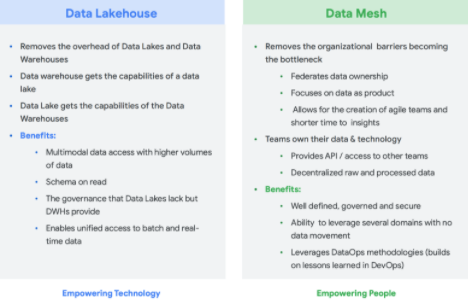Share this
The End of Data Silos? How to Unify Your Data Warehouse and Data Lake
by Crystalloids Team on Aug 24, 2021 10:51:04 AM

For many years, the architectures of a data warehouse and a Data Lake were viewed as separate, siloed systems. That's history. Today, the focus isn't on choosing one over the other but on building a single, comprehensive platform that gives us the best of both worlds, powered by a new generation of cloud technologies.
We have been creating end-to-end solutions that cover all data management and processing stages, from collection to data analysis and machine learning. The result is a unified data platform that can store vast amounts of data in varying formats without compromising on latency. This platform satisfies the needs of all users throughout the data lifecycle, whether they require the structured environment of a data warehouse for BI or the raw, flexible storage of a data lake for AI development.
Building an end-to-end data solution has no one-size-fits-all approach. The conversation has moved beyond simple lakehouses. Emerging concepts like data lakehouses, data meshes, and the AI-native data fabric are now key to meeting specific technical and organisational needs. All of these work naturally and powerfully within a Google Cloud environment. We have several clients who are enjoying the benefits of these converging technologies.
The New Paradigms: Unifying Your Data for the AI Era
New architectural patterns have completely erased the traditional lines between a data warehouse and a data lake.
-
A data lakehouse is a cornerstone of this shift, combining the low-cost storage of a data lake with the schema and governance of a data warehouse. It's now the standard for building a centralised, reliable repository that supports both traditional analytics and machine learning on the same data.
-
A data mesh facilitates a decentralised approach to data ownership. This is no longer just a theoretical concept; it's a practical way for large enterprises to empower individual business units to treat their data as a product, publishing and subscribing to it in a standardised, governed manner.
-
An AI-native data fabric is the next evolution. It's an intelligent layer that leverages AI and metadata to automate data discovery, governance, and integration across all your sources. This is critical for powering real-time analytics and generative AI, which require a unified, secure view of all data.
In Google Cloud, these concepts need not be separate. Thanks to the interoperability among our data analytics products, you can easily provide access to data residing in different places, effectively bringing your data lake and data warehouse together on a single, intelligent platform.
AI and Cloud Technology that Bridge the Gap
Let's look at some of the technological innovations that make this reality in 2025. The core principle remains a decoupled architecture that separates compute and storage, but AI now supercharges it.
BigQuery, our serverless data warehouse, has become a complete analytics platform. Its Storage API, for instance, allows you to treat the data warehouse as a data lake, letting you access data residing in BigQuery using other tools like Spark without affecting the performance of any other jobs. BigQuery is also fully integrated with generative AI, offering features like vector search and BigQuery Studio, a unified data engineering, analytics, and machine learning environment.
Likewise, Dataplex, Google’s intelligent data fabric service, is no longer just a governance tool. It provides an AI-native foundation for managing and securing your data across various storage tiers, from raw data in Cloud Storage to curated data in BigQuery. With features like the Dataplex business glossary and AI-powered data insights, it provides consistent governance and security across your entire data estate.
A Truly Unified, AI-Powered Analytics Platform: The Google Cloud Difference
What sets Google Cloud’s data analytics platform apart in 2025 is that it is open, intelligent, flexible, and tightly integrated by design. Many technologies in the market provide tactical solutions that may feel comfortable and familiar.
Share this
- November 2025 (2)
- October 2025 (2)
- September 2025 (3)
- August 2025 (2)
- July 2025 (1)
- June 2025 (1)
- April 2025 (4)
- February 2025 (2)
- January 2025 (3)
- December 2024 (1)
- November 2024 (5)
- October 2024 (2)
- September 2024 (1)
- August 2024 (1)
- July 2024 (4)
- June 2024 (2)
- May 2024 (1)
- April 2024 (4)
- March 2024 (2)
- February 2024 (2)
- January 2024 (4)
- December 2023 (1)
- November 2023 (4)
- October 2023 (4)
- September 2023 (4)
- June 2023 (2)
- May 2023 (2)
- April 2023 (1)
- March 2023 (1)
- January 2023 (4)
- December 2022 (3)
- November 2022 (5)
- October 2022 (3)
- July 2022 (1)
- May 2022 (2)
- April 2022 (2)
- March 2022 (5)
- February 2022 (2)
- January 2022 (5)
- December 2021 (5)
- November 2021 (4)
- October 2021 (2)
- September 2021 (1)
- August 2021 (3)
- July 2021 (4)
- May 2021 (2)
- April 2021 (2)
- February 2021 (2)
- December 2020 (1)
- October 2020 (2)
- September 2020 (1)
- August 2020 (2)
- July 2020 (2)
- June 2020 (1)
- March 2020 (2)
- February 2020 (1)
- January 2020 (1)
- November 2019 (3)
- October 2019 (2)
- September 2019 (3)
- August 2019 (2)
- July 2019 (3)
- June 2019 (5)
- May 2019 (2)
- April 2019 (4)
- March 2019 (2)
- February 2019 (2)
- January 2019 (4)
- December 2018 (2)
- November 2018 (1)
- October 2018 (1)
- September 2018 (2)
- August 2018 (3)
- July 2018 (3)
- May 2018 (2)
- April 2018 (4)
- March 2018 (5)
- February 2018 (1)
- January 2018 (3)
- November 2017 (2)
- October 2017 (2)



